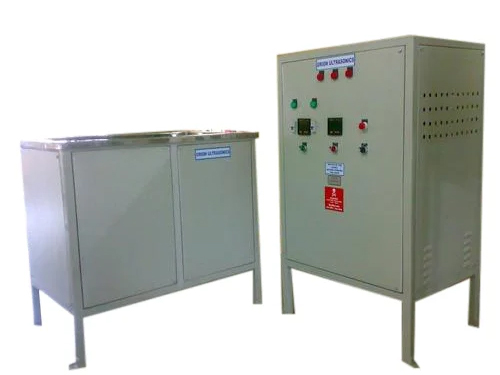
Single Ultrasonic Cleaners
Working Principles: A single ultrasonic cleaner employs a process known as cavitation to achieve superior cleaning results. The cleaner consists of a stainless-steel tank filled with a cleaning solution, usually water or a specialized cleaning agent. When the ultrasonic cleaner is turned on, high-frequency sound waves, typically in the range of 20 kHz to 40 kHz, are generated by transducers located at the bottom of the tank.
These sound waves create alternating high-pressure and low-pressure cycles within the cleaning solution, causing microscopic bubbles to form and collapse rapidly. This phenomenon is known as cavitation. The collapse of these bubbles generates millions of tiny shockwaves and microjets, which dislodge and remove dirt, grime, oils, and other contaminants from the surface of the objects being cleaned. The cleaning solution acts as a medium to transmit the ultrasonic energy and aid in the cleaning process.
Key Features
- 1.Tank Capacity: Single ultrasonic cleaners come in various tank sizes, allowing users to select a size that best suits their cleaning needs. The tank capacity typically ranges from a few liters to tens of liters, accommodating objects of different sizes and quantities.
- 2.Timer and Temperature Control: Many single ultrasonic cleaners offer programmable timers and temperature control features. Users can set the desired cleaning time and temperature to optimize the cleaning process for different objects and contaminants. Timer settings help prevent overexposure to ultrasonic waves, while temperature control allows for efficient cleaning by optimizing the cleaning solution's effectiveness.
- 3.Adjustable Power Settings: Ultrasonic cleaners often come with adjustable power settings to accommodate different cleaning requirements. Users can adjust the intensity of the ultrasonic waves according to the type and stubbornness of the contaminants, ensuring effective and safe cleaning.
- 4.Degas Function: Some models of single ultrasonic cleaners feature a degas function. This function removes trapped air from the cleaning solution by subjecting it to ultrasonic waves before the cleaning process begins. Removing air bubbles enhances the cavitation effect, ensuring optimal cleaning performance.
- 5.Basket and Lid: Single ultrasonic cleaners usually include a removable basket or tray for easy loading and unloading of objects. The basket helps keep objects separated and submerged during the cleaning process. Additionally, a lid is often provided to minimize evaporation of the cleaning solution and reduce noise during operation.
Applications: The versatility of a single ultrasonic cleaner makes it suitable for a wide range of applications, including:
- 1.Jewelry Cleaning: From delicate gemstones to metal bands, a single ultrasonic cleaner can effectively remove dirt, oils, and tarnish from jewelry, restoring their shine and luster.
- 2.Precision Instrument Cleaning: Single ultrasonic cleaners are widely used in industries such as electronics, optics, and watchmaking to clean delicate components, circuit boards, lenses, and other precision instruments. The gentle yet powerful cleaning action ensures thorough cleaning without causing damage.
- 3.Automotive Parts Cleaning: Ultrasonic cleaners are ideal for removing grease, oil, and carbon buildup from automotive parts such as carburetors, fuel injectors, valves, and gears. The cleaning process reaches even the tiniest crevices, providing a thorough cleaning that manual methods often cannot achieve.
- 4.Medical and Dental Instrument Cleaning: Single ultrasonic cleaners are crucial in healthcare settings for cleaning medical instruments, dental tools, and surgical equipment.
